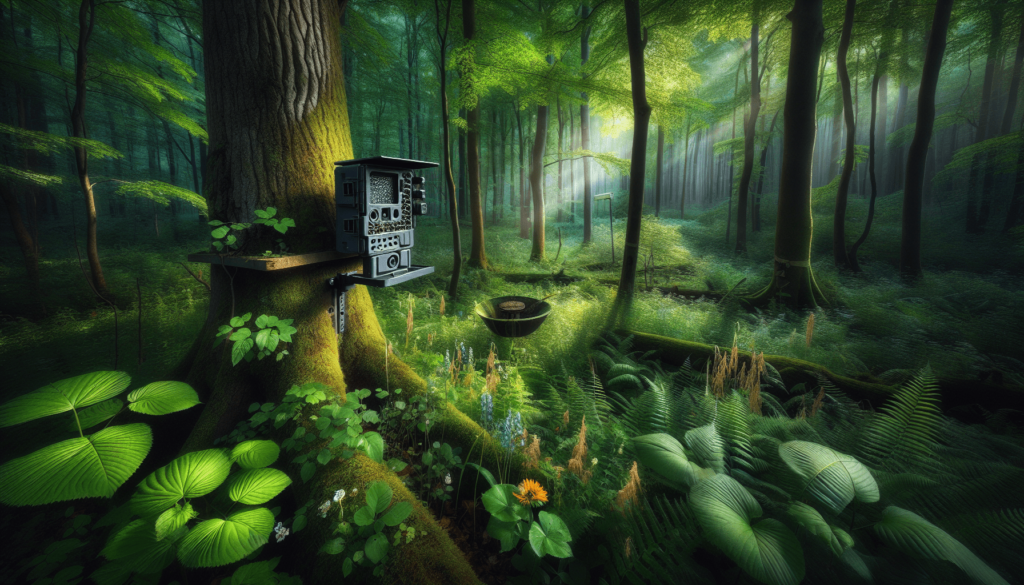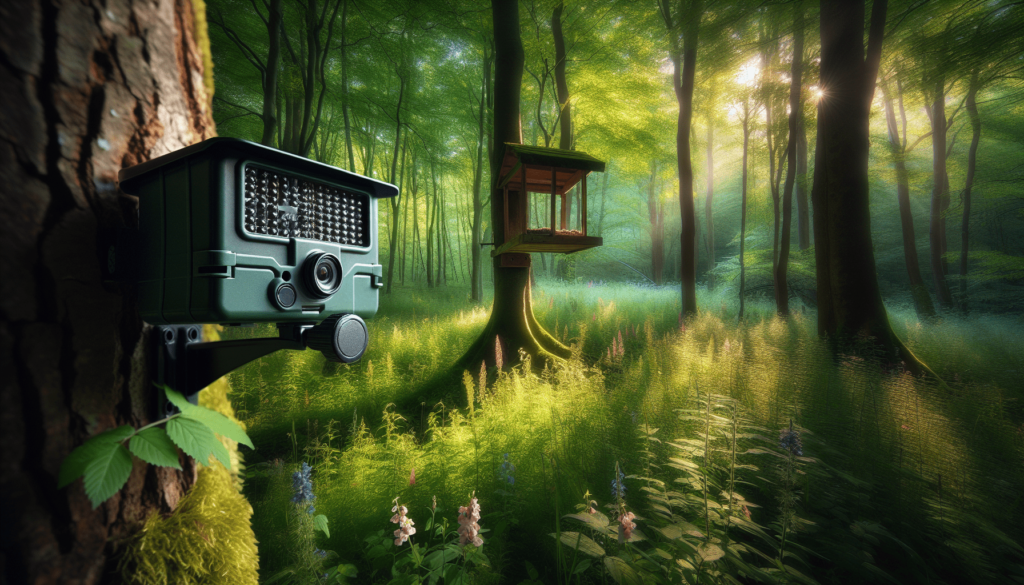
Have you ever wondered how to ensure your deer feeder is effective? It’s not just about setting it up and hoping for the best. Monitoring is essential if you want to attract and feed deer intentionally. Integrating trail cameras into your strategy opens up a whole new world of possibilities for understanding wildlife behavior and optimizing feeder success.

Understanding Deer Behavior
Deer are incredible creatures with complex patterns of behavior. By understanding these patterns, you can enhance the effectiveness of your feeding strategies.
Food Preferences
Deer have specific dietary preferences that vary based on their habitat and the season. While deer are grazers, they often prefer certain foods at different times of the year. Understanding what they enjoy can help you choose the right feed to attract them to your feeder.
- Spring and Summer: During these warmer months, deer typically enjoy fresh greens, fruits, and legumes.
- Fall and Winter: As the weather turns colder, their diet shifts to acorns, hickory nuts, and supplemental feed that provides energy.
Knowing their food preferences allows you to tailor your feeder contents further.
Activity Patterns
Deer are most active during dawn and dusk, often referred to as crepuscular activity. Being aware of these patterns can help you set up your trail cameras at the right times.
- Morning and Evening: Focusing your camera settings around these times ensures that you capture the most activity near your feeder.
- Seasonal Changes: As seasons change, so do deer behaviors. In the colder months, you may find that deer are more inclined to visit feeders frequently.
Why Use Trail Cameras?
Utilizing trail cameras can provide invaluable insights into your deer population and feeder success. You might think of them as your eyes in the woods, allowing you to observe without intrusive presence.
Capturing Animal Activity
Trail cameras allow you to see which deer are visiting your feeder and when. This information can help you understand their habits better, including:
- Frequency of Visits: How often do deer return to the feeder? This data allows you to gauge the attractiveness of the feed.
- Gender Ratios: Understanding the mix of bucks and does visiting can lead to more tailored feeding strategies.
Monitoring Feeder Efficacy
With the help of trail cameras, you can assess the efficacy of your feeder over time.
- Feed Consumption: Seeing how quickly your feed disappears gives you a better idea of whether adjustments are needed.
- Health Assessment: Observing the physical condition of deer and any unusual behaviors can signal health issues within local deer populations.
Choosing the Right Trail Camera
Choosing the right trail camera is crucial for capturing high-quality images and videos. You’ll want to ensure you’re getting a camera suited to your needs and environment.
Key Features to Consider
When selecting a trail camera, keep an eye out for these key features:
| Feature | Importance |
|---|---|
| Resolution | Higher resolution provides clearer images. |
| Trigger Speed | Quick trigger speeds capture fast-moving deer. |
| Weather Resistance | Ensure durability against outdoor elements. |
| Battery Life | Long-lasting batteries reduce maintenance. |
| Storage Capacity | Larger storage accommodates more pictures/videos. |
Recommended Brands
Some brands consistently receive high marks for performance and durability. While personal preferences will vary, consider looking into:
- Moultrie: Known for user-friendly interfaces and robust models.
- Bushnell: Offers excellent image quality and durability.
- Reconyx: A higher-end option known for fast trigger speeds and longevity.
Setting Up Your Trail Camera
Proper setup is essential for getting the most out of your trail camera. You want to position it in a way that maximizes your chances of capturing deer activity.
Location, Location, Location
The placement of your camera can make or break its effectiveness. Consider the following tips:
- Near the Feeder: Position the camera within sight of your feeder to capture deer as they approach. This helps in monitoring feeding habits.
- Travel Trails: If there are known trails deer frequently use, set the camera there, so you catch them on their way to and from the feeder.
Height and Angle
You’ll also want to think about the height and angle at which you mount your camera.
- Height: Aim for 3 to 4 feet off the ground to capture images at the deer’s eye level.
- Angle: Tilting the camera slightly downward can help frame the deer better in the shot.

Analyzing Your Data
Once your camera is set up and running, checking and analyzing the captured images will be vital to your deer management practices.
Recording Visits
Document the number of visits your feeder receives. It’s not just enough to see deer; you want to understand the trends over time.
- Daily Logs: Keep a record of daily visits. This helps spot patterns over weeks or months.
- Seasonal Changes: Watch how visitation patterns change with seasonal shifts, adjusting your feeding strategies accordingly.
Behavior Observations
Over time, you’ll start to notice behaviors, such as:
- Feeding Preferences: Which types of feed do deer tend to eat first?
- Social Behavior: Are deer feeding alone or in groups? This can indicate social dynamics within the herd.
Adjusting Your Feeder Strategy
Armed with insights from your trail camera data, it’s time to optimize your feeding strategy for improved deer attraction.
Diversifying Feed Types
Experimenting with different feed types may yield surprising results. If you find that certain blends are not attracting deer, consider diversifying your offerings.
| Feed Type | Advantages |
|---|---|
| Corn | Popular and energy-rich, commonly used. |
| Soybeans | High in protein, great for attraction. |
| Mineral Blocks | Can help maintain deer health and attract them. |
Timing Your Feedings
Timing can also greatly affect the success of your feeder. Adjusting your feeding times based on the camera data can help.
- Consistency: Deer are creatures of habit. Feeding at the same time daily can create a routine.
- Adaptation: Be willing to experiment with feeding times based on deer activity patterns observed.
Dealing with Challenges
While monitoring deer feeder success may seem straightforward, you may encounter challenges that can affect your results.
Competition from Other Animals
Uninvited guests can be a hassle when you’re trying to attract deer to your feeder.
- Identify: Use your trail camera to identify which other animals are visiting.
- Adjust Setup: Sometimes, relocating the feeder or altering the feed type can deter unwanted visitors and encourage deer.
Weather Considerations
Weather can significantly influence deer behavior.
- Rain and Snow: Monitor weather patterns and how they affect deer visits. They might be less active in heavy rain or snow.
- Seasonal Changes: Adjust feeding quantities and types to align with seasonal deer behaviors.
Enhancing Security
Securing your trail camera and feeder is paramount, especially if you’re hoping to continue monitoring deer over time.
Camera Locking Mechanisms
Consider investing in locks or security boxes for your trail camera to prevent theft.
- Straps and Locks: Use sturdy straps with locks to affix your camera securely to trees.
- Covers: Weather-resistant covers can help protect your camera from the elements as well.
Feeder Security
Ensure your feeder is also safe from theft and unwanted animal interference.
- Bear-Proof Design: If you’re in an area with bears, look for bear-proof models or secure your feeder with additional weights.
- Maintenance Checks: Regularly check your feeder for wear and tear to ensure it remains functional.
Involving Others in Monitoring
If you’re really keen on maximizing your deer feeder’s success, consider involving friends, family, or local hunting groups.
Sharing Insights
Creating a community around deer management can lead to shared data and insights.
- Group Monitoring: By pooling resources, you might find it easier to monitor multiple feeders.
- Workshops: Hosting gatherings to share photos and data can lead to valuable discussions and discoveries.
Hunting Seasons
As hunting seasons approach, you can use your gathered data to refine your strategies even more.
- Buck Counts: Understand which bucks are on your property and their activity before the season starts.
- Movement Patterns: Adjust your approach according to deer movement as hunting season begins.
Conclusion
Monitoring the success of your deer feeder doesn’t have to be a solo endeavor. By integrating technology like trail cameras and keeping a close watch on deer behaviors, you can create a feeding strategy that truly captivates the local wildlife. With attention to detail and a willingness to adapt, you can enhance your experience in the woods, creating a harmonious relationship with the deer community. After all, understanding these magnificent creatures not only supports their health but enriches your time in nature too.





